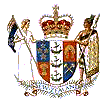

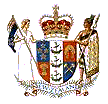



 Document 2
Document 2
RESTRICTED
__________
National Security Systems Directorate
Counter Terrorism 1982
Playbook Act
Information
DEPARTMENT
of the PRIME MINISTER
and CABINET
Official
the National Security Systems Directorate
under
Released
11 July 2018
RESTRICTED
__________
1 of 56
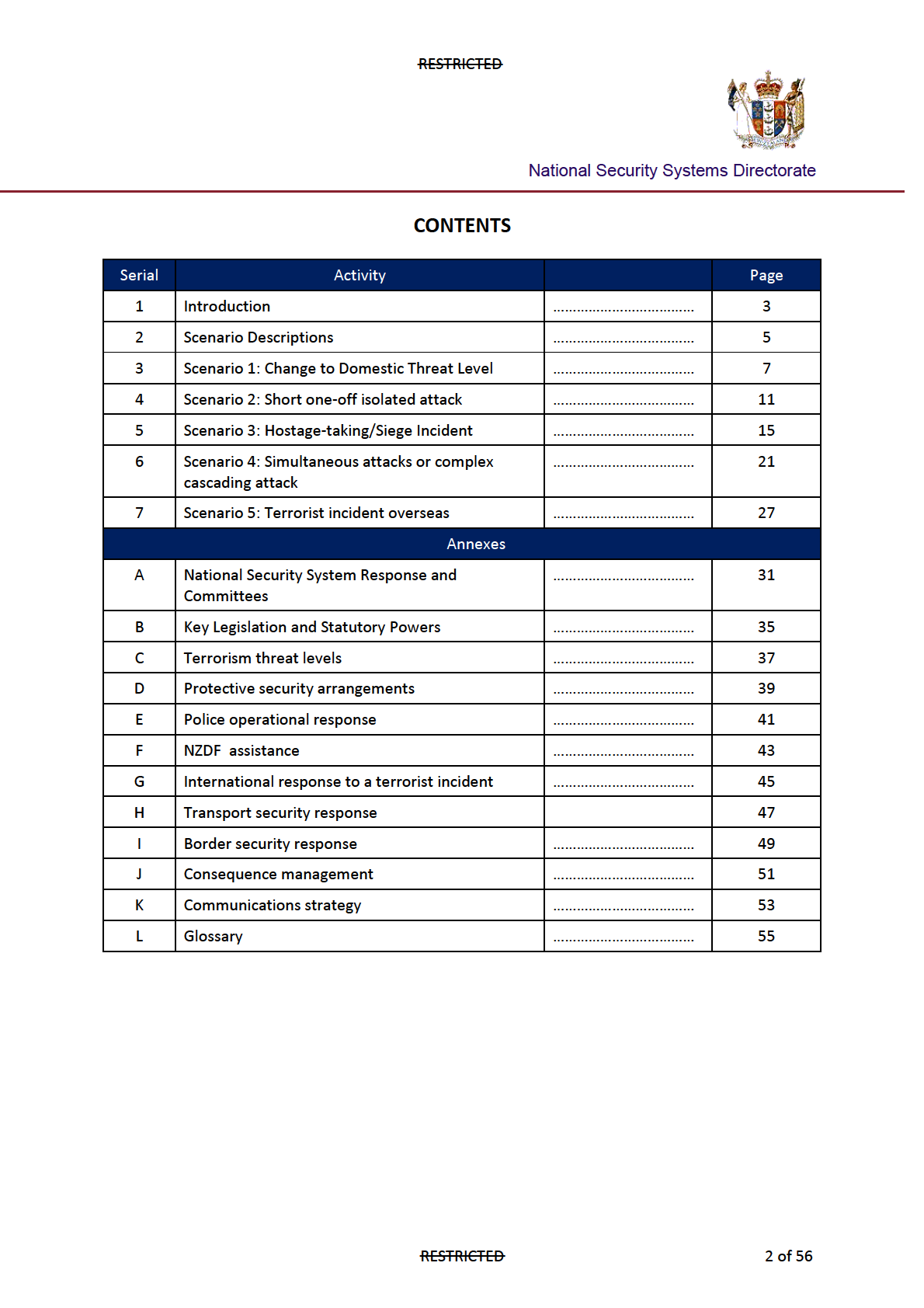
1982
Act
Information
Official
the
under
Released
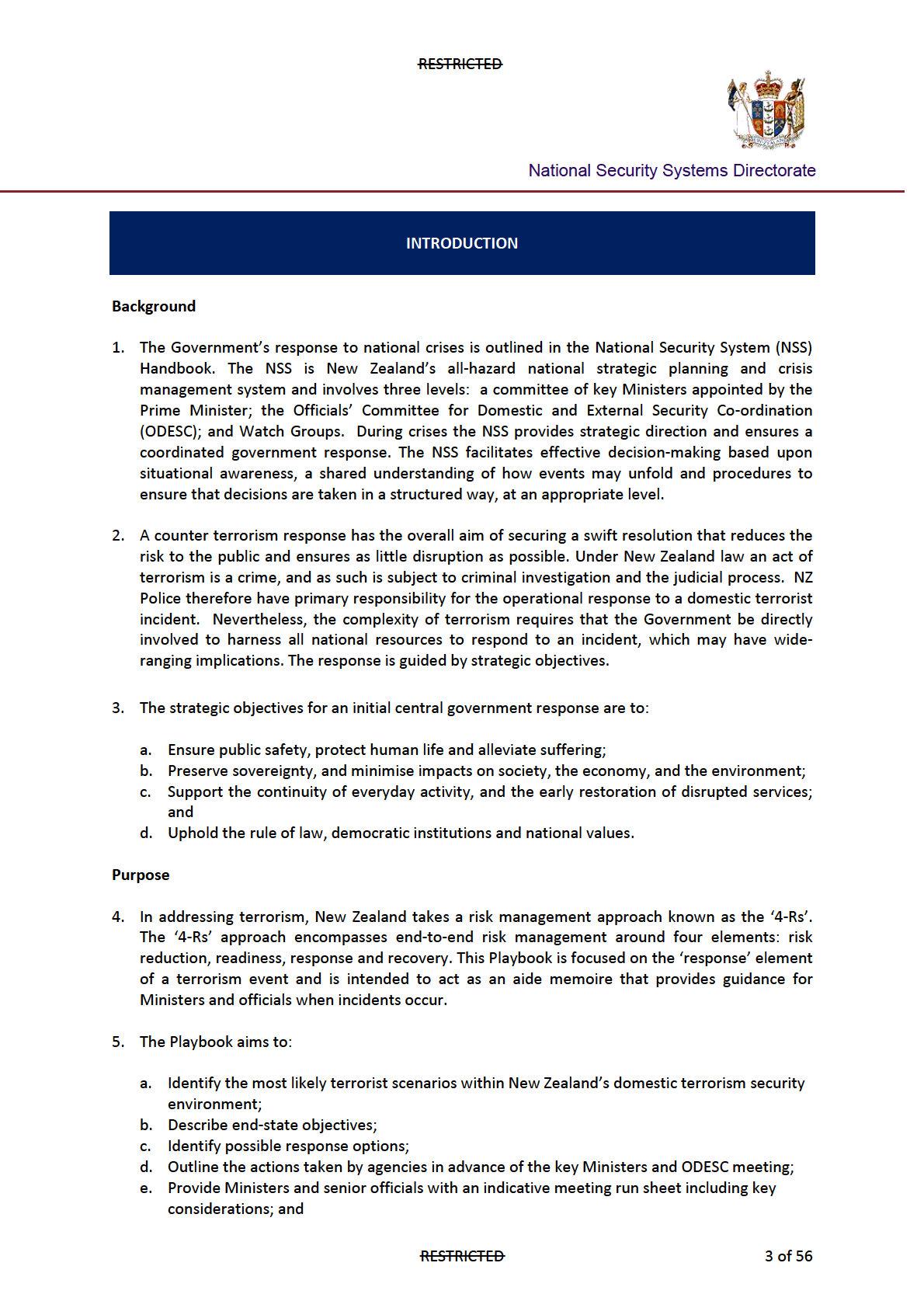
1982
Act
Information
Official
the
under
Released
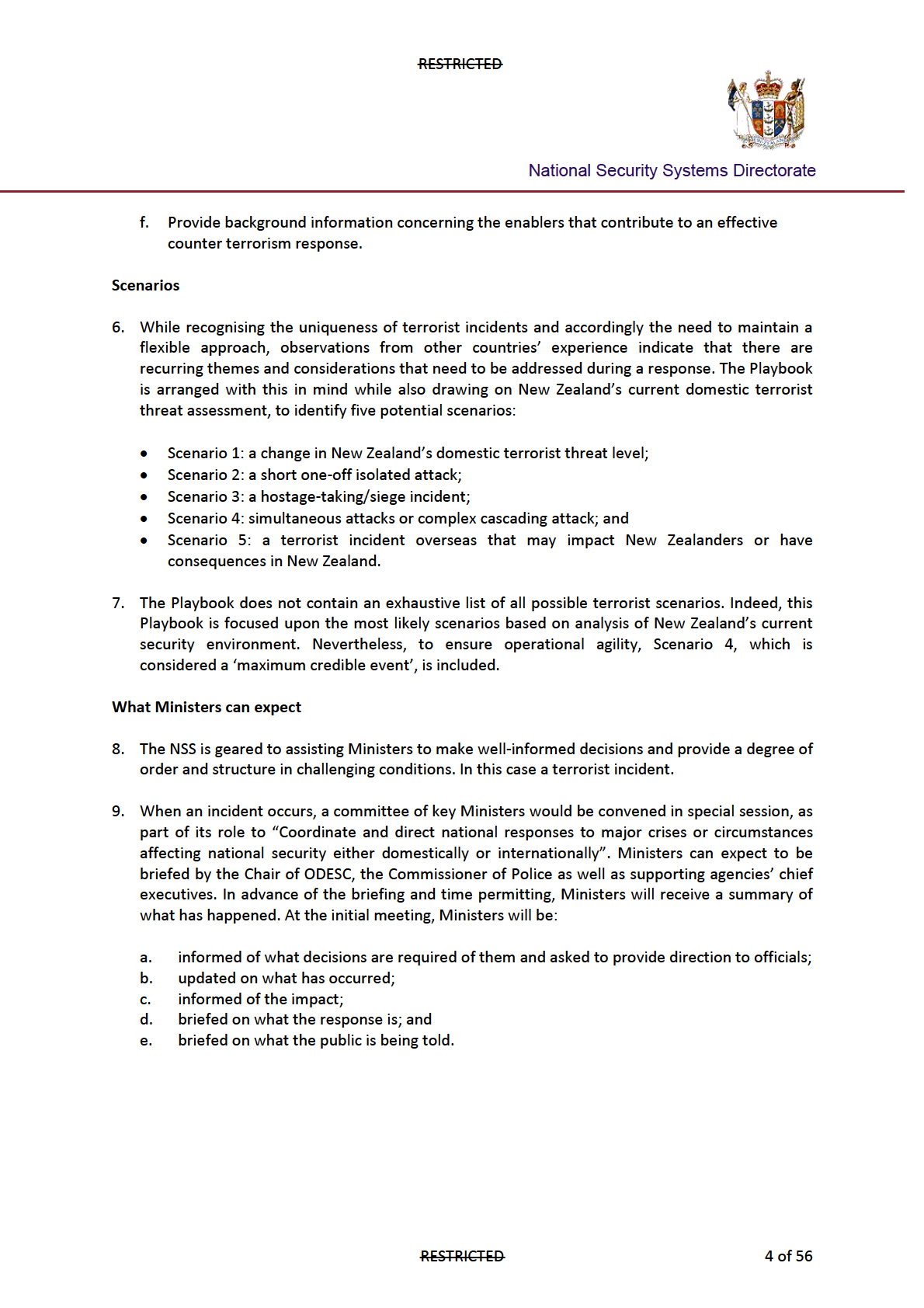
1982
Act
Information
Official
the
under
Released

RESTRICTED
National Security Systems Directorate
SCENARIO DESCRIPTIONS
Scenario 1 – Change to the domestic threat level
1982
This scenario is based upon credible intelligence that terrorists are discussing or undertaking activities
that lead to an assessment that there is a potential threat to public safety in New Zealand. In this
situation, the Combined Threat Assessment Group (CTAG)
will raise New Zealand’s domestic threat
Act
level
.
The threat level could range from
MEDIUM
to
EXTREME depending upon a number of factors including
the plausibility of the scenario, the intent and capability of the terrorists, and imminence of an attack.
An elevation of New Zealand’s terrorism threat level would result in an activation of the national
security system to consider the implications, coordinate the government response and consider the
advice to the public. An explanation of the threat levels is attached at Annex B.
Scenario 2 – Short one-off isolated attack
Information
This scenario envisages a scenario where a lone actor conducts a low-level planned or spontaneous
attack using readily available implements.
An example is the 2017 Westminster attack that occurred on 22 March. 52-year-old Khalid Masood
drove a hire car onto London’s Westminster Bridge, mounted the vehicle onto the pavement and
accelerated into pedestrians. Masood then drove the vehicle around permanent bol ards at the end
Official
of the bridge before remounting the pavement and crashing the car. Masood abandoned the vehicle
and proceeded on foot into the Houses of Parliament complex via the Carriage Gates—temporarily
open to allow a vehicle to exit—and used t
the wo kitchen knives to attack two unarmed police officers,
kil ing one and injuring the other. An armed police close protection officer then shot and killed
Masood.
The attack lasted 82 seconds and resulted in six deaths, including Masood’s, and 49 people injured.
It was an unsophisticated delibera
under te terrorist attack using a car and knives as weapons. In the follow-
up investigation it was determined that Masood acted alone.
Scenario 3 – Hostage-taking/Siege Incident
This scenario envisages a situation where a lone actor takes one or more hostages and the incident
evolves into a protracted siege.
Released
The 2014 Sydney hostage crisis, also known as the Lindt Cafe siege occurred on 15–16 December 2014
when a lone gunman, Man Haron Monis, held hostage ten customers and eight employees of a Lindt
chocolate café located at Martin Place in Sydney, Australia. Police treated the event as a terrorist
attack at the time but Monis' motives have subsequently been debated. The Sydney siege led to a 16-
hour standoff, after which a gunshot was heard from inside and police officers from the Tactical
Operations Unit stormed the café. One hostage was kil ed by Monis and another was killed by a police
bul et ricochet in the subsequent raid. Monis was also killed. Three other hostages and a police officer
were injured by police gunfire during the raid.
RESTRICTED
5 of 56
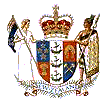
RESTRICTED
National Security Systems Directorate
Scenario 4 – Simultaneous attacks or complex cascading attack
This scenario envisages a more complex and coordinated attack where attacks are carried out
simultaneously at two or more locations; or where an attack cascades from location to location,
potentially involving different methodologies.
1982
Examples of this include the Paris attacks in 2015 and the London Borough Market attacks in 2017.
The Paris attacks involved three co-ordinated groups using firearms and explosives to target different
Act
locations, including a sports event, music concert and restaurants. One hundred and thirty people
were killed and 413 injured over a three hour period. In London, three individuals drove a rental
vehicle into pedestrians before abandoning the vehicle and moving into a shopping and tourist area
by foot. Bladed weapons taped to the individuals’ hands were used to stab and slash people as they
went, before the attackers were shot by armed response Police. The attack lasted 18 minutes and
killed eight people and injured 48.
Scenario 5 - Terrorist incident overseas that impacts New Zealand and/or New Zealanders
This scenario addresses the issue of international terrorist incidents and their potential impact to New
Information
Zealand and/or New Zealanders.
New Zealand has one of the biggest expatriate diasporas in the developed world, as many as a mil ion
people which is approximately 25% of our population. Furthermore, Statistics New Zealand report that
2.39 million New Zealanders went on overseas trips in 2015. Against this backdrop, when terrorist
incidents occur overseas there is always the potential for New Zealanders to be affected. Alternatively,
Official
there are international terrorist incidents, which require New Zealand to review its current security
settings to determine if a similar threat exists here or if vulnerabilities have been exposed. Examples
are the IED attack outside of Ariana Grande
the ’s concert in Manchester in May 2017 or the thwarted plot
to bring down an airplane in Sydney in July 2017. Incidents such as these may cause a limited activation
of the National Security System to assess the implications for New Zealand.
under
Released
[
Pages 7 to 30 inclusive withheld in full under section 6(a)]
RESTRICTED
6 of 56

RESTRICTED
National Security Systems Directorate
ANNEX A
National Security System Response
Role
1982
The purpose of the National Security System during a terrorist incident is to provide Government a
framework that enables it to exercise leadership in crisis conditions.
Act
How does the national security system respond?
When an incident occurs or is imminent, the Chief Executive of DPMC who is the lead official for
national security will activate the national security system. The national security system consists of:
• Key Ministers, led by the Prime Minister;
• The Officials Committee for Domestic and External Security Coordination (ODESC) consisting of
Chief Executives led by the Chief Executive of DPMC ;
Information
• A Watch Group consisting of senior officials led by the Deputy Chief Executive, Security and
Intelligence, DPMC;
• A lead agency (Police) responsible for leading the operational response; and
• Supporting agencies.
Official
The National Security System provides for a coordinated government response in which:
•
risks are identified and managed;
the
•
the response is timely and appropriate;
•
national resources are applied effectively;
•
adverse outcomes are minimised;
•
multiple objectives are dealt with together; and
•
agencies’ activities are coordinated.
under
How does it work?
The ODESC will meet in advance of the key Ministers and focus on the strategic consequences arising
from the incident and develop advice for Ministers to consider. In addition, a brief would be provided
to Ministers covering: the intelligence picture (including a threat assessment), the operational
response, communication messages and other key matters such as the international reaction and
impact to communities. As well as providing advice, there will typically be issues or matters that
Released
require decisions by Government.
The Watch Group supports ODESC and accordingly wil meet frequently to ensure that there is
situational clarity, that the response is coordinated and strategic direction is being followed through
by the response agencies.
RESTRICTED
31 of 56
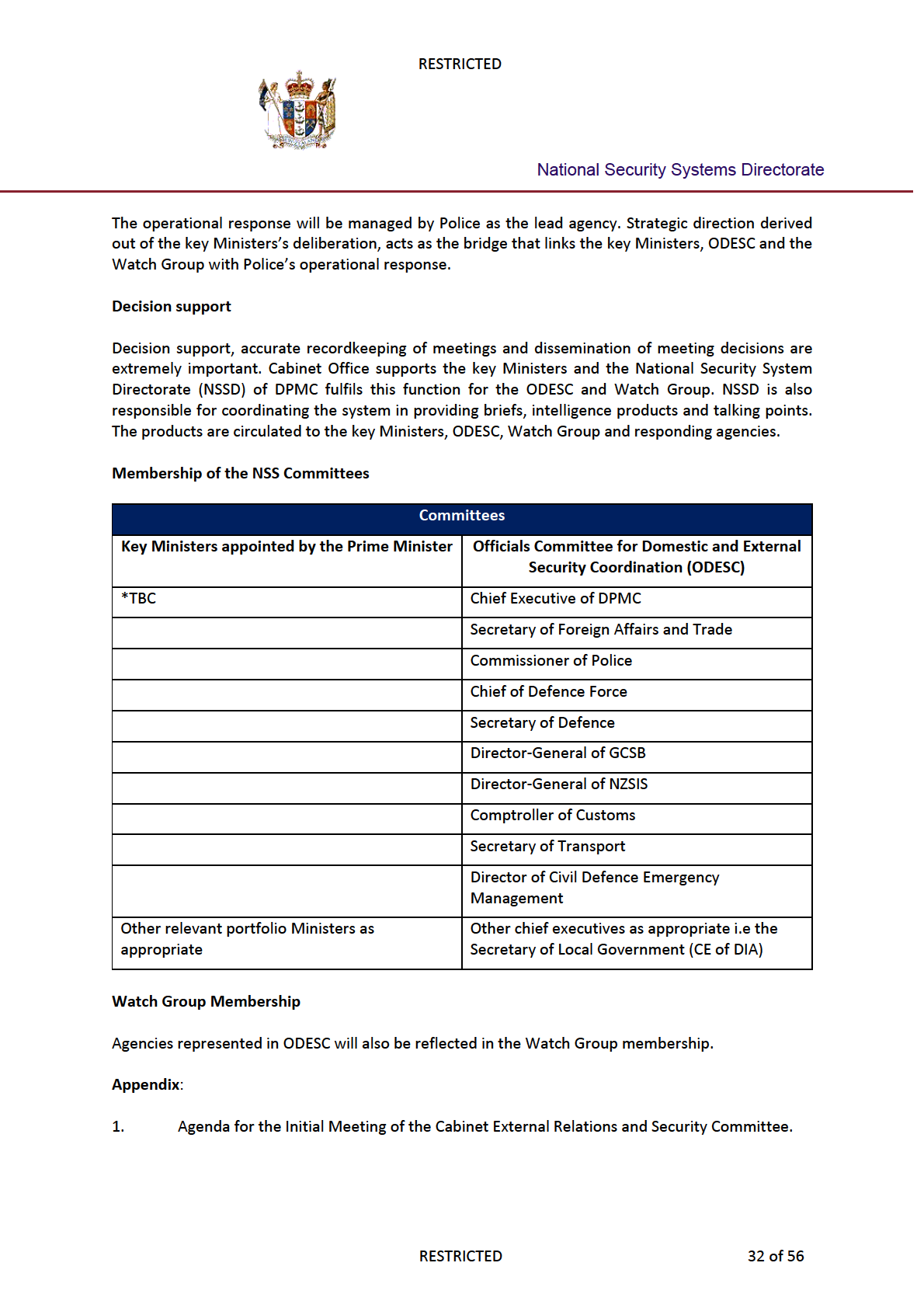
1982
Act
Information
Official
the
under
Released
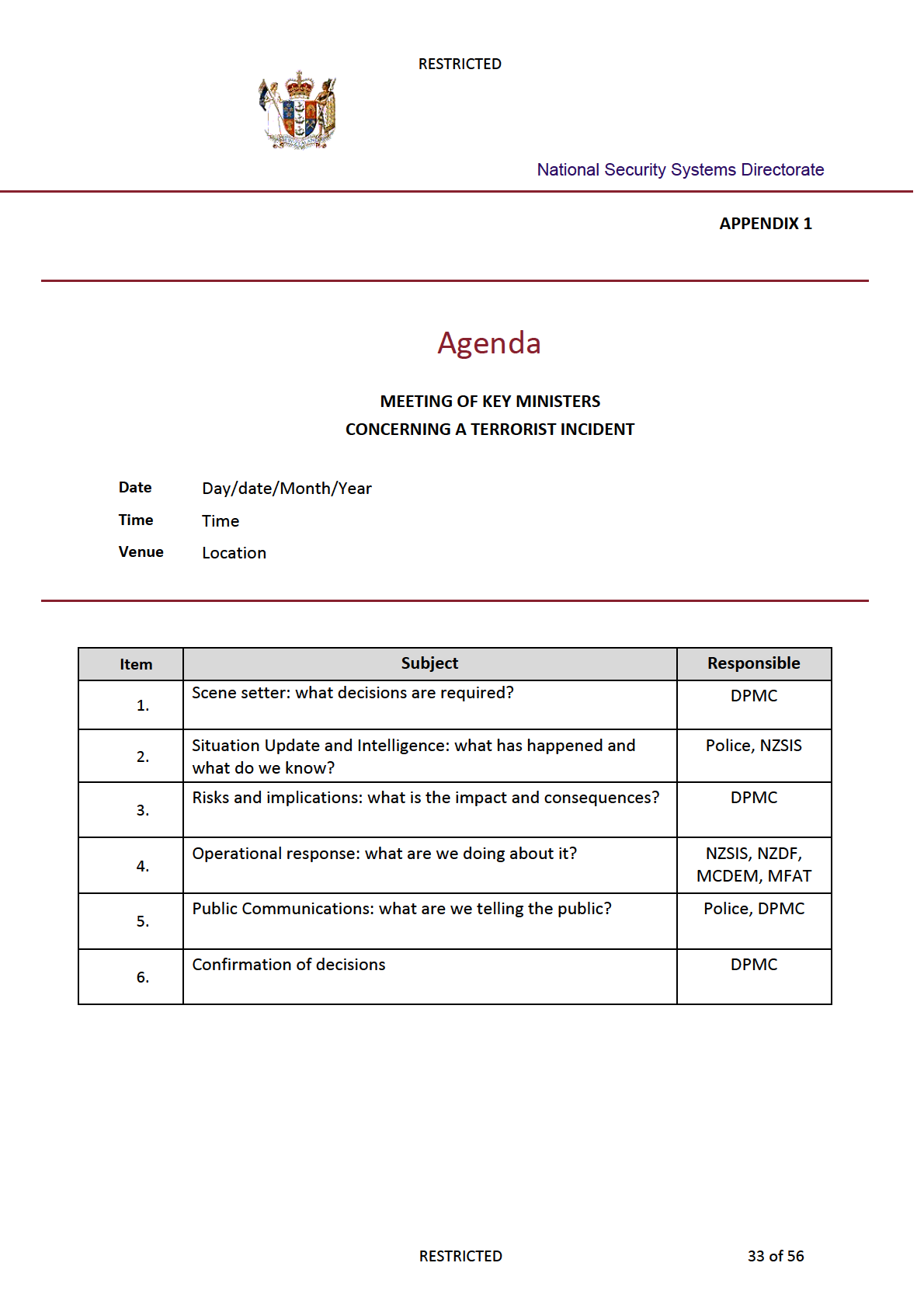
1982
Act
Information
Official
the
under
Released
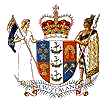
RESTRICTED
National Security Systems Directorate
1982
Act
[Page intentional y Blank]
Information
Official
the
under
Released
RESTRICTED
34 of 56
s6(a)
1982
Act
Information
Official
the
under
Released
s6(a)
1982
Act
Information
Official
the
under
Released
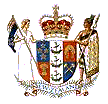
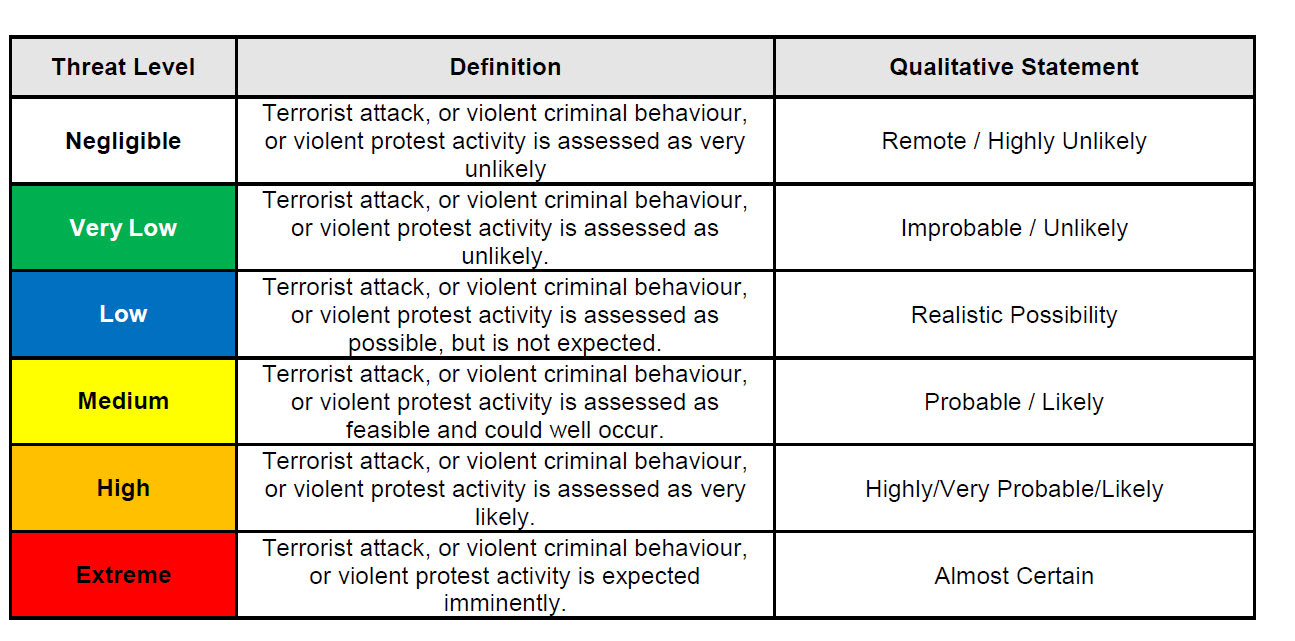
RESTRICTED
National Security Systems Directorate
ANNEX C
TERRORISM THREAT LEVELS
Setting the Terrorism Threat Level
1982
The threat level for New Zealand is set by the Combined Threat Assessment Group (CTAG). CTAG is a
multi-agency fusion centre with an autonomous mandate to assess the threat to New Zealand and
New Zealand interests from terrorism. CTAG monitors and revises the New Zealand domestic
Act
terrorism threat level as required. CTAG also sets and revises threat levels for countries and major
events. In the event of a terrorist incident the process to change the domestic threat level is
considered within the national security system resulting in advice from ODESC to the Prime Minister.
A threat level may or may not be publicly announced.
Terrorism Threat Levels
The threat levels are:
Information
Official
the
under
Figure 1: CTAG terrorism threat levels and associated probabilistic language
How are threat levels determined?
The New Zealand threat level is determined strictly in accordance with New Zealand conditions. It
does not necessarily change when attacks occur overseas or when partners change their threat levels.
It is intelligence-based and is an indication of likelihood of a terrorist event based on intent and
Released
capability of terrorist actors and their potential opportunity to enact that intent and capability in the
form of an attack.
The terrorism threat level may be increased fol owing a domestic attack but this is not an automatic
reaction. An increase would denote that further attacks are considered feasible, likely or imminent;
or that they cannot be conclusively discounted because of intelligence and operational information
gaps.
RESTRICTED
37 of 56

RESTRICTED
National Security Systems Directorate
1982
Act
Information
[Page intentional y Blank]
Official
the
under
Released
RESTRICTED
38 of 56
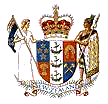
RESTRICTED
National Security Systems Directorate
ANNEX D
PROTECTIVE SECURITY RESPONSE
Protective Security Response
1982
In response to an attack or serious threat, the key Ministers will receive advice from the ODESC on the
protective security measures it may wish to implement around the specific targets of the terrorist
activity or in general. Protective security measures help mitigate the risks to the public and the public
Act
sector.
s6(a)
Information
Official
the
The Public Sector
With respect to the public sector, the New Zealand Government’s Protective Security Requirements
(PSR) requires agencies to have plans and protocols in place so they can move to heightened security
under
levels in case of an emergency or increased threat
. To assist in the implementation of appropriate
security arrangements, the PSR National Alert Levels provides generic guidance to agencies on what
measures they need to initiate.
How are the security measures implemented?
Police would be responsible for notifying the public of an increase to security in response to a threat
or incident. This would be done alongside coordinated communications to the public concerning the
Released
risk. With respect to the public sector, ODESC would initiate the protective security arrangements.
Once direction is passed to agencies, it is the responsibility of agency Chief Security Officers (CSOs) to
ensure implementation of security measures.
It should be noted, that the National Alert Levels and the detail of the security measures taken to
protect people and the government are not publically discussed, to avoid unnecessary disclosure of
security arrangements.
RESTRICTED
39 of 56
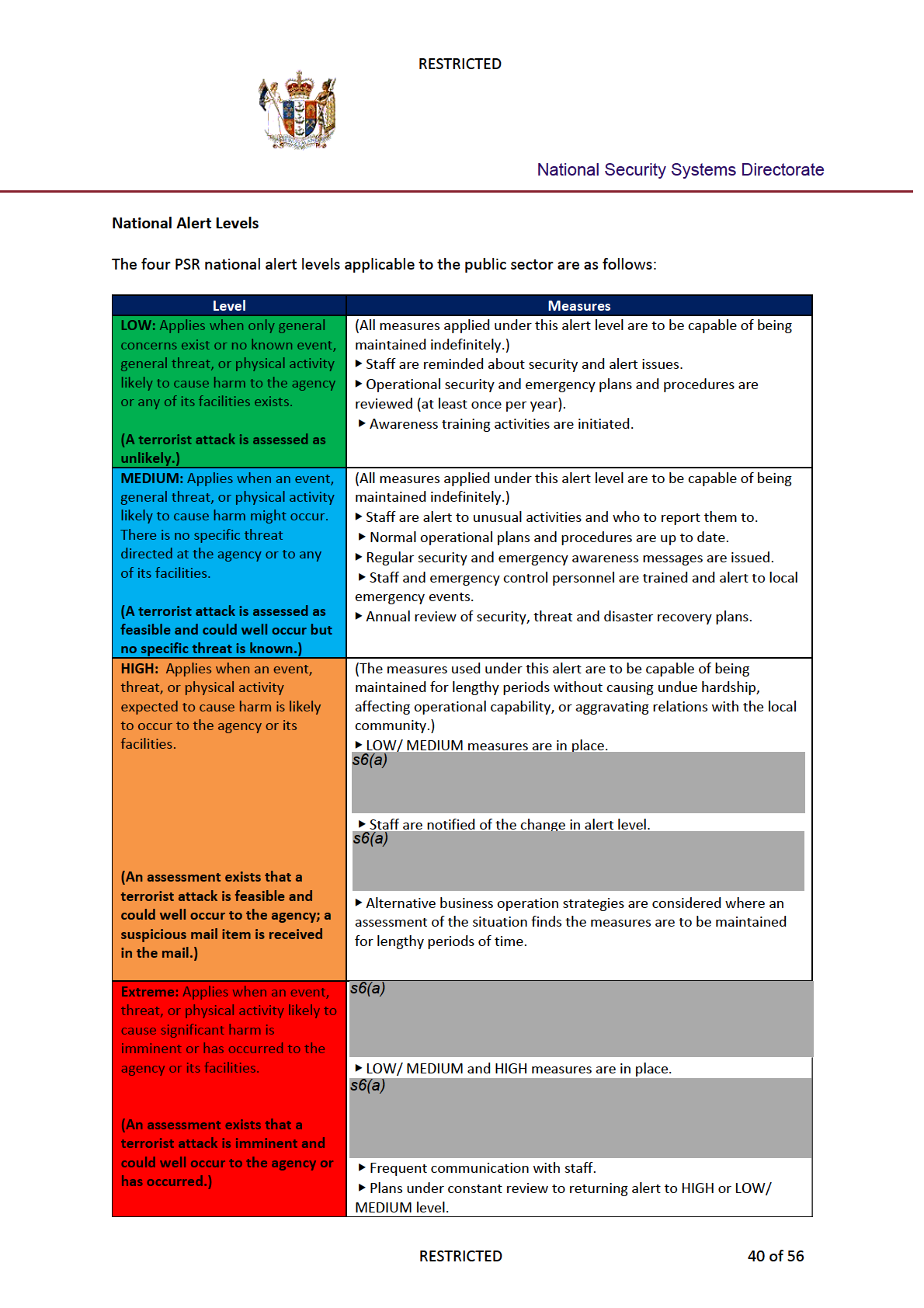
1982
Act
Information
Official
the
under
Released
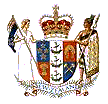
RESTRICTED
National Security Systems Directorate
ANNEX E
POLICE OPERATIONAL RESPONSE
1982
Legislative authority of New Zealand Police in Counter Terrorism
The fundamental power authorising New Zealand Police (NZP) to provide the response to any terro
Act rist
threat or incident in a domestic setting arises from the Crimes Act, and the Constabulary powers within
the Policing Act. These powers are then implemented through the Police Counter Terrorism (CT)
Standard Operating Procedures (SOPs).
Police procedures in response to a change in threat level or Counter Terrorist (CT) event
NZP are the designated lead agency, providing command and control of the multi-agency response to
any CT event in New Zealand.
Information
In response to a terrorist incident, or where there is intelligence of an imminent threat, there would
be an increase in the number of visible policing resources.
s6(a)
Official
the
under
Released
RESTRICTED
41 of 56
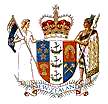
RESTRICTED
National Security Systems Directorate
s6(a)
1982
Act
Command, control and coordination
Initial coordination of a terrorist incident wil be managed by the National Communications (Comms)
Centre. This role will transition to the relevant District Command Centre (12 DCCs nationally) in a
protracted incident.
Oversight wil be maintained by the National Command and Coordination Centre (NCCC) based at
Police National Headquarters.
Information
The Local Controller (District Commander) is responsible for command, co-ordination and control of
the terrorist incident within their district, subject to any direction by the National Controller.
The National Control er (Assistant Commissioner) has the overal control and command of any
domestic CT event, on behalf of the Commissioner.
s6(a)
Official
and dependent on the nature of the CT event, may instigate
the activation of the National Crisis Management Centre (NCMC) and wil then operate from there.
The Police structure, roles and responsibilitie
the s for a CT operation at the national level is detailed in the
NZP Standard Operating Procedures (SOP) for a Terrorist event.
under
Released
RESTRICTED
42 of 56
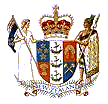
RESTRICTED
National Security Systems Directorate
ANNEX F
NZDF ASSISTANCE
Legislated employment of the NZDF in accordance with the Defence Act 1990
1982
Within the parameters of a domestic counter terrorism (CT) response, the NZDF may be used to
provide assistance to NZ Police, as the lead agency, through:
Act
• The provision of personnel and capabilities where NZDF do not have the same powers as the
Police. This may include, but is not limited to, helicopter support, logistics support, support to
cordons, and use of armoured vehicles as protected mobility.
• The provision of personnel and capabilities where NZDF personnel shal :
o For any purpose necessary to assist the Police in dealing with the emergency, exercise any
power of a member of the Police; and
o For the purposes of civil and criminal liability, have the protections of a member of the
Police, in addition to all other protections that members of the Armed Forces may have.
Information
Where NZDF personnel are given the same powers and immunities as a member of the NZ Police,
NZDF assistance could include the deployment of Special Forces (SF) and the potential use of deadly
force to assist in resolving the situation.
Approvals to employ NZDF in response to a domestic CT response.
Official
Where NZDF personnel do not require any power of a member of the police, the Chief of the Defence
Force can approve their deployment at the request of NZ Police.
the
Where NZ Police request that NZDF personnel be given the same powers and immunities as a member
of the NZ Police, approval resides with the Prime Minister or the next most senior Minister.
s6(a)
under
Released
RESTRICTED
43 of 56

RESTRICTED
National Security Systems Directorate
s6(a)
1982
Act
What factors should be considered in providing NZDF assistance?
• What support do the Police need and where?
• What will be the impact of deploying the military to the security situation?
• What impact wil the deployments have on public confidence and community cohesion?
• What is the plan for ramping down the military deployment?
• How will we explain to the public what we are doing?
Information
Official
the
under
Released
RESTRICTED
44 of 56
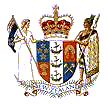
RESTRICTED
National Security Systems Directorate
ANNEX G
INTERNATIONAL RESPONSE TO A DOMESTIC TERRORIST INCIDENT
MFAT provides the principal interface between the New Zealand Government, foreign governments
and international organisations. Our international priorities in responding to a domestic terrorist
1982
threat will be to:
1. Coordinate offers of or requests for international support in response to the incident. Act
2. Retain the confidence of the international community that the New Zealand Government is
effectively managing the incident.
3. Support foreign diplomatic and consular missions accredited to New Zealand to fulfil their
consular responsibilities to nationals affected by the incident.
4. Minimise any negative impact on New Zealand’s trade and international relations.
5. Enable effective investigation of international linkages, including cooperation with foreign
governments on any residual or emerging threats.
In the event of a significant incident, MFAT leads the international function including the provision of
advice on foreign policy, international security, international relations and trade implications in
Information
support of the lead domestic response agency, Police.
International responses
The attitudes and responses of foreign governments and other international stakeholders can add a
complicated dimension to a domestic terrorist crisis. These include, but may not be limited to:
Official
• Travel advisories issued by foreign governments;
the
• Requests for information on the situation from foreign governments;
• Views on the New Zealand response to the crisis;
• Potential impact on trade interests, such as negative reactions from the tourism or international
education sectors;
• International media interest;
under
• Circumstances in other countries contributing directly or indirectly to the crisis (including such as
would make ancillary terrorist targets of a diplomatic or foreign character located in
New Zealand).
MFAT wil seek to manage the reaction of the international community through engagement with
accredited diplomatic missions and consular posts in New Zealand, as well as directly with foreign
governments via its network of posts overseas. MFAT will coordinate messaging to foreign
governments in accordance with the communications strategy, noting that in some instances it will be
Released
desirable to share information with trusted foreign partners over and above that available in the public
domain.
MFAT will also seek to ensure the travel advice for New Zealand issued by foreign governments is
proportionate, recognising that influence wil be limited. Countries with mechanistic systems could
advise against travel to New Zealand in the event of a terrorist incident, which may have negative
consequences for tourism or business.
RESTRICTED
45 of 56
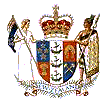
RESTRICTED
National Security Systems Directorate
Enquiries from international news media will be referred to the national communications lead.
International Assistance
Foreign governments may offer assistance or expertise to help respond to a domestic terrorist
incident. This could be offered through a variety of channels, including diplomatic, Police, Defence or
1982
other agency channels. MFAT has responsibility for coordinating offers of international assistance in
conjunction with relevant agencies. Similarly, MFAT will play a coordinating role should the
New Zealand Government wish to seek the assistance of foreign government in response to the event.
Act
Foreign consular responsibilities
Any domestic terrorist incident in New Zealand could include foreign national victims. Following a
terrorist incident, the foreign diplomatic and consular corps will seek information directly from MFAT
on whether any of their nationals are either involved or affected. MFAT and Police will work together
to respond to enquiries and deliver consistent messages to diplomatic and consular contacts.
Depending on the nature, scope and details of the incident, this could include providing regular email
sitreps or briefings to the diplomatic and consular corps. Any unavoidable delay between an incident
and authorisation for the release of information to foreign governments will need to be taken into
Information
account.
Should there be a large-scale event, MFAT will engage with the diplomatic corps. For small-scale
events affecting few foreign nationals, Police will notify missions directly. Police will also work with
missions should there be fatalities. Affected foreign governments may also wish to send
representatives to New Zealand to observe resolution of the incident, or assist in any other way on
Official
the ground. New Zealand also has international legal obligations in respect of consultation and
assistance in the event that foreign diplomatic, consular or other government officials present in
New Zealand are taken hostage, or in the e
the vent of a terrorist attack on a diplomatic establishment or
foreign aircraft in New Zealand.
VIP Visitors
MFAT, in conjunction with DIA’s V
under isits and Ceremonial Office as appropriate, will assist high level
foreign government VIP visitors in New Zealand who have been affected by a domestic terrorist
incident. Should a visiting VIP be directly involved in a terror incident, MFAT will work with the relevant
Embassy or High Commission to provide necessary support. If the incident only affects visit
programme and logistics, MFAT may work with the relevant diplomatic mission to modify or adjust
visit programmes accordingly. Consideration wil also need to be given to any impact on planning for
future incoming high level visits.
Released
Investigations
New Zealand Police and other relevant agencies, supported as needed by MFAT and its international
network, wil work with foreign governments to understand whether the incident or threat has
international links, including to determine whether foreign partners are aware of information
regarding residual threats to New Zealand linked to the incident.
RESTRICTED
46 of 56
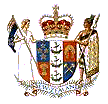
RESTRICTED
National Security Systems Directorate
ANNEX H
TRANSPORT SECURITY RESPONSE
Transport Response Team
1982
The Transport Response Team wil activate, during a counter-terrorism response, to support the
New Zealand Police as the lead agency.
Act
The Transport Response Team consists of the Ministry of Transport (as the lead agency for the
transport sector response), the New Zealand Transport Agency, the Civil Aviation Authority,
Maritime New Zealand, and Kiwirail (Airways NZ and the Transport Accident Investigation
Commission can also participate in the Transport Response Team as required). The Transport
Response Team can be represented by the Ministry of Transport at Watch Group meetings and
ODESC meetings. The Transport Response Team is also connected, via the Ministry of Transport, to
the Minister of Transport. The Minister of Transport may not a member of the key Ministers
committee established in response to a terrorist incident, but can be invited to attend by the
committee chair if required.
Information
Aviation security and airspace closures
The Minister of Transport and the Director of Civil Aviation have powers to introduce enhanced
aviation security screening requirements in response to a security risk.
The Director of Civil Aviation also has the power to place restrictions on airspace, including directing
Official
the closure of New Zealand airspace. The complete closure of New Zealand airspace is an extreme
measure with widespread impacts. The committee of key Ministers can request the Director of Civil
Aviation to use their powers (to restrict airs
the pace) to close New Zealand airspace.
Road and rail closures
Various agencies have powers to close roads, with the New Zealand Police and Fire and Emergency
New Zealand having the power to
under close al roads; the New Zealand Transport Agency having the
power to close State highways; and local authorities having the power to close local roads under
their authority.
Fire and Emergency New Zealand and the New Zealand Transport Agency have powers relating to
railway closure.
Released
RESTRICTED
47 of 56

RESTRICTED
National Security Systems Directorate
1982
Act
[Page intentionally Blank]
Information
Official
the
under
Released
RESTRICTED
48 of 56
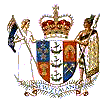
RESTRICTED
National Security Systems Directorate
ANNEX I
BORDER SECURITY RESPONSE
Border Security
1982
NZ Border Agencies the New Zealand Customs Service (NZCS) and Immigration New Zealand
(INZ) work together across individual and overlapping spheres of responsibility to facilitate
legitimate transit of passengers (NZCS/INZ) and goods (NZCS) across the NZ border while
Act
identifying and acting on potential risk. NZCS and INZ can coordinate to manage risk at the
earliest possible point by sharing information on specific risk indicators, and support lead CT
agencies NZSIS and NZ Police by passing on CT-related intelligence and assisting in border-
related activity 24/7. Both agencies use a combination of manual and automated targeting
and direct interdiction, informed by profiles that are constantly reviewed and updated based
on local and international events, trends and risk factors.
s6(a)
Information
Official
the
Domestic Incident Response - How is it escalated?
under
Escalation of response at the border across relevant streams of responsibility would be
initiated at the request or direction of lead agencies and NZ Government. Response and
activity may also be escalated internally at any time as required, based on credible risk/threat
information or indicators.
s6(a)
Released
RESTRICTED
49 of 56
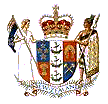
RESTRICTED
National Security Systems Directorate
s6(a)
1982
Act
Information
Official
the
under
Released
RESTRICTED
50 of 56
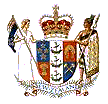
RESTRICTED
National Security Systems Directorate
ANNEX J
CONSEQUENCE MANAGEMENT
The Civil Defence Emergency Management (CDEM) Act 2002 identifies the statutory powers,
1982
structures, and arrangements that the government uses to manage an emergency. It also places
obligations on agencies to prepare for and manage emergencies effectively and efficiently.
Act
The National CDEM Plan 2015 aims to integrate and align agencies’ CDEM planning and related
operational activities at the national level. It also identifies those agencies, as mandated through
legislation or expertise, to manage an emergency arising from specific hazards. The specific hazard,
and its primary consequences to be managed in an emergency, determines which agency is the lead
at the national level. The National CDEM Plan 2015 specifies that the NZ Police is the lead agency for
terrorism.
Consequence management response
A potential or actual terrorist incident is likely to have a number of impacts outside the immediate
Information
response to the terrorist activity. These could include lockdown of school and businesses,
displacement of individuals, transport disruption, and demand for information.
In response to a terrorism event, or where there is intelligence of an imminent threat, it has been pre-
agreed that MCDEM wil coordinate the consequence management for the event in support of Police,
as the lead agency. This allows the Police to focus on the resolution of the terrorist element of the
Official
emergency.
Consequence management includes measu
the res taken to preserve public health and safety, restore
essential services, and provide emergency relief to communities, businesses and individuals affected
by the terrorist incident. Consequence management response could include:
• Emergency accommodation (eg for evacuated individuals)
under
• Public information (what is going on and what they should do)
• Working with lifelines, especially transport, to restore essential services
• Provision of emergency relief such as financial assistance
Released
RESTRICTED
51 of 56
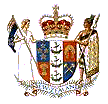
RESTRICTED
National Security Systems Directorate
1982
Act
[Page intentional y Blank]
Information
Official
the
under
Released
RESTRICTED
52 of 56

RESTRICTED
National Security Systems Directorate
ANNEX K
COMMUNICATIONS STRATEGY
CT Communications
1982
The management of pubic communications both during and fol owing a terrorist event wil play a
critical role in both:
Act
• protecting the public from harm; and
• supporting the public and communities recovering from a terrorist experience.
In any event there wil be a need for both Public Information Management (PIM) function and Strategic
Communications function.
PIM Communications
New Zealand Police as lead agency are responsible for public information in any terrorism incident.
The PIM is based in the National Command and Coordination Centre (NCCC) at Police National
Information
Headquarters. The function is prepared and practiced and fol ows the PIM Standard Operating
Procedures.
PIM responsibilities:
Official
• ensuring timely, consistent and effective messaging for the public
• liaising and responding to the media
• monitoring and analysing media reporting and information and advising on appropriate
the
communications strategies
PIM messaging is focused on informing the public about the incident and advising them on how to
keep safe. They may also seek cooperation or information from the public.
under
Strategic Communications
The Strategic Communications function provides high level oversight and issues management when
the National Security System is activated.
Strategic Communications responsibilities:
• supporting an advising the Officials Domestic External Security Coordination Committee
Released
(ODESC) and watch groups
• providing messaging and advice to the Prime Minister’s Office and other Ministers’ Offices
• providing information and advice to Chief Executives and other key stakeholders
• liaising with the media, government departments, local authorities and private sector entities
The Strategic Communications function looks at what is happening across agencies, communities and
the media in an event or emergency to provide advice and manage risk and opportunities.
RESTRICTED
53 of 56
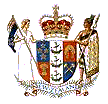
RESTRICTED
National Security Systems Directorate
It would support Ministerial level public messaging focused on reassurance, de-escalation, recovery,
and social cohesion.
Expected Communications Chal enges
No two terrorist events are the same, but there are a number of communications chal enges that can
1982
be expected at both the operational and strategic levels:
• Providing accurate information to support public safety information in fast-moving,
Act
potential y confused situation
• Pressure to confirm an attack as a “terrorist” attack in an environment in which facts and
information about the individuals involved, their motives and intent may be limited
• Pressure to confirm the resolution of the immediate threat and to provide public reassurance,
in situations where intelligence and facts are still being brought together
• Proliferation of information and misinformation via social media
• Ensuring appropriate engagement with key community groups and leaders, as message
alignment with the local authority/authorities is critical
Information
Official
the
under
Released
RESTRICTED
54 of 56

RESTRICTED
National Security Systems Directorate
ANNEX L
GLOSSARY
Abbreviation
Description
1982
AIC
……………
Ad-hoc Intelligence Coordinator
AOS
……………
Armed Offenders Squad (Police)
Act
CE
……………
Chief Executive
CTAG
……………
Combined Threat Assessment Group
C2
……………
Command and Control
C3I
……………
Command, Control, Communication and Intelligence
CIMS
……………
Coordinated Incident Management System
CoP
……………
Commissioner of Police
CSO
……………
Departmental Chief Security Officer
CTG
……………
Counter Terrorist Group (NZDF)
Information
CT
……………
Counter Terrorism
DCoP
……………
Deputy Commissioner of Police
D I&A
……………
Director of Intelligence and Assessments
ECC
……………
Emergency Coordination Centre
Official
ERS
……………
Cabinet External Relations and Security Committee
4-Rs
……………
Reduction, Readiness, Response and Recovery
the
GLN
……………
Government Legal Network
IC
……………
Incident Control er
ICP
……………
Incident Control Point
ITOC
……………
Integrated Targeting and Operations Centre
(Customs House – Auckland)
under
JIG
……………
Joint Intelligence Group (Police)
LC
……………
Local Controller
NAB
……………
National Assessments Bureau, NSG, DPMC
NC
……………
National Controller
NCMC
……………
National Crisis Management Centre, Beehive
Released
Basement, Parliament
NCC
……………
National Coordination Centre
NCTP
……………
National Counter Terrorism Plan
NSG
……………
National Security Group, DPMC
NSS
……………
National Security System
NSSD
……………
National Security Systems Directorate, NSG, DPMC
NZP
……………
New Zealand Police
RESTRICTED
55 of 56
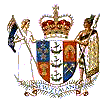
RESTRICTED
National Security Systems Directorate
NZCS
……………
New Zealand Customs Service
ODESC
……………
Officials’ Committee for Domestic and External
Security Co-ordination
PIM
……………
Public Information Management
1982
PNHQ
……………
Police National Headquarters
PNT
……………
Police Negotiation Team
Act
SCIF
……………
Secure Compartmentalised Information Facility
SOP
……………
Standard Operating Procedure
STG
……………
Special Tactics Group (Police)
TIC
……………
Terrorism Intelligence Centre (NZSIS)
Information
Official
the
under
Released
RESTRICTED
56 of 56




































